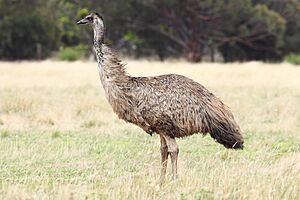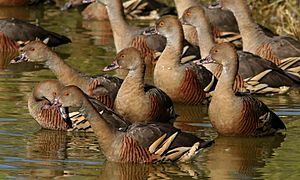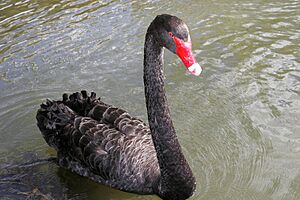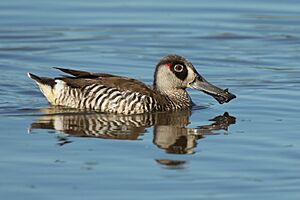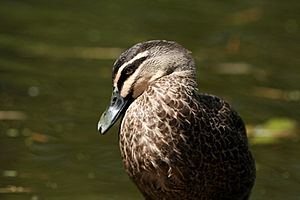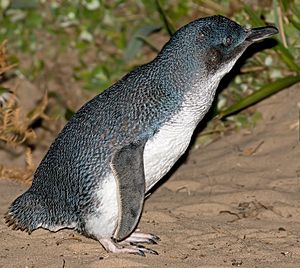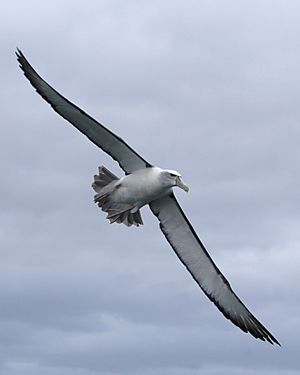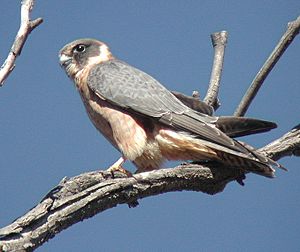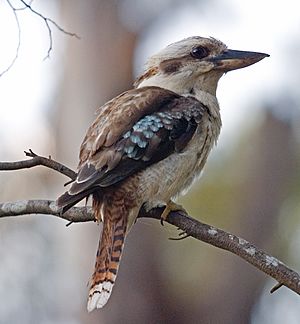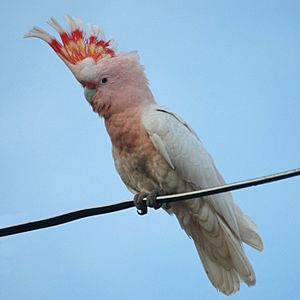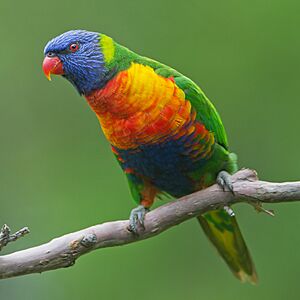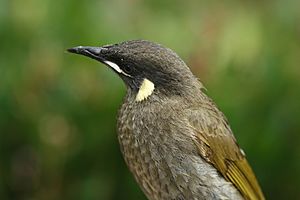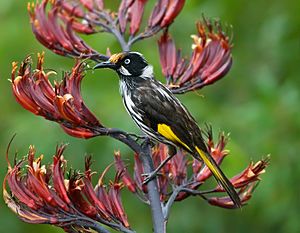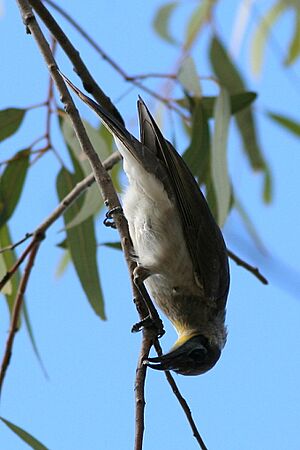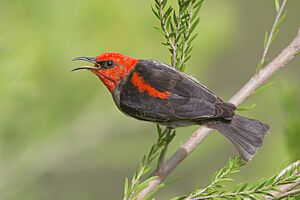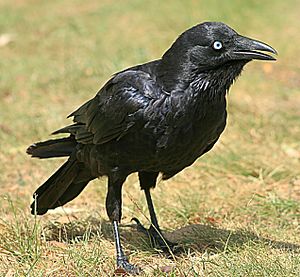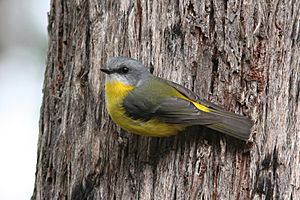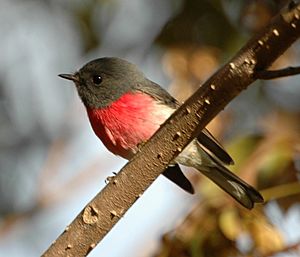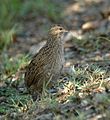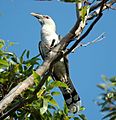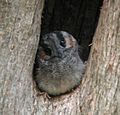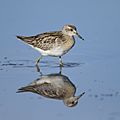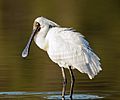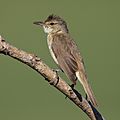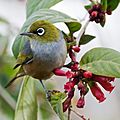List of birds of Australia facts for kids
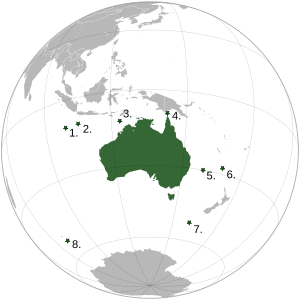
1. Cocos (Keeling) Islands
2. Christmas Island
3. Ashmore Reef
4. Torres Strait Islands
5. Lord Howe Island
6. Norfolk Island
7. Macquarie Island
8. Heard Island and McDonald Islands
This is a list of the wild birds found in Australia, including its many islands and territories like Christmas Island, Cocos (Keeling) Islands, Ashmore Reef, Torres Strait Islands, Coral Sea Islands, Lord Howe Island, Norfolk Island, Macquarie Island, and Heard Island and McDonald Islands. It does not include the Australian Antarctic Territory. This list also features birds that have been introduced by people, common visitors (called vagrants), and species that have recently become extinct. In total, about 980 living and extinct bird species are included here.
For a long time, people have been studying and writing about Australia's birds. Famous works include John Gould's The Birds of Australia from the 1840s and the more recent Handbook of Australian, New Zealand and Antarctic Birds (1990-2006).
Cassowaries and Emu
Order: Casuariiformes Family: Casuariidae
2 species recorded [2 extant native]
This family includes two amazing flightless birds found in Australia: the Southern Cassowary and the Emu. Two other species live in New Guinea. Emus from King Island and Kangaroo Island were once thought to be different species, but scientists now believe they are the same as mainland emus.
| Common name | Binomial | Notes |
|---|---|---|
| Southern cassowary | Casuarius casuarius | |
| Emu | Dromaius novaehollandiae |
Ducks, Geese, and Waterfowl
Order: Anseriformes Family: Anatidae
32 species recorded [20 extant native, 4 introduced, 7 vagrant, 1 hybrid]
This family includes ducks, geese, and swans. These birds are perfectly built for life in water. They have webbed feet, flat bills, and special oily feathers that shed water easily. Australia is home to many of these birds, including some that were introduced by people and others that are just visiting.
| Common name | Binomial | Notes |
|---|---|---|
| Spotted whistling-duck | Dendrocygna guttata | |
| Plumed whistling-duck | Dendrocygna eytoni | |
| Wandering whistling-duck | Dendrocygna arcuata | |
| Canada goose | Branta canadensis | vagrant, presumably from introduced NZ population |
| Domestic greylag goose | Anser anser | introduced |
| Cape Barren goose | Cereopsis novaehollandiae | |
| Freckled duck | Stictonetta naevosa | |
| Mute swan | Cygnus olor | introduced |
| Black swan | Cygnus atratus | |
| Radjah shelduck | Radjah radjah | |
| Australian shelduck | Tadorna tadornoides | |
| Paradise shelduck | Tadorna variegata | vagrant, Lord Howe Island & NSW |
| Green pygmy-goose | Nettapus pulchellus | |
| Cotton pygmy-goose | Nettapus coromandelianus | |
| Australian wood duck | Chenonetta jubata | |
| Garganey | Spatula querquedula | |
| Australian shoveler | Spatula rhynchotis | |
| Northern shoveler | Spatula clypeata | vagrant |
| Eurasian wigeon | Mareca penelope | vagrant |
| Pacific black duck | Anas superciliosa | |
| Domestic mallard | Anas platyrhynchos domesticus | introduced |
| Pacific black duck × mallard hybrid | Anas superciliosa × platyrhynchos | native × introduced hybrid |
| Domestic muscovy duck | Cairina moschata domesticus | introduced |
| Northern pintail | Anas acuta | vagrant |
| Green-winged teal | Anas crecca | vagrant, Cocos (Keeling) Island |
| Grey teal | Anas gracilis | |
| Chestnut teal | Anas castanea | |
| Pink-eared duck | Malacorhynchus membranaceus | |
| Hardhead | Aythya australis | |
| Tufted duck | Aythya fuligula | vagrant |
| Blue-billed duck | Oxyura australis | |
| Musk duck | Biziura lobata |
Penguins
Order: Sphenisciformes Family: Spheniscidae
14 species recorded [7 extant native, 7 vagrant]
Penguins are amazing birds that cannot fly, but they are excellent swimmers! They mostly live in the Southern Hemisphere, especially around Antarctica. Only one type, the Australian little penguin, makes its home and raises its young on Australia's coast.
| Common name | Binomial | Notes |
|---|---|---|
| King penguin | Aptenodytes patagonicus | Macquarie & Heard Island; mainland vagrant |
| Emperor penguin | Aptenodytes forsteri | vagrant, Macquarie & Heard Island |
| Adélie penguin | Pygoscelis adeliae | vagrant, TAS, Macquarie & Heard Island |
| Gentoo penguin | Pygoscelis papua | Macquarie & Heard Island; mainland vagrant |
| Chinstrap penguin | Pygoscelis antarcticus | vagrant, VIC, TAS, Macquarie & Heard Island |
| Australian little penguin | Eudyptula novaehollandiae | |
| Magellanic penguin | Spheniscus magellanicus | vagrant |
| Fiordland penguin | Eudyptes pachyrhynchus | |
| Erect-crested penguin | Eudyptes sclateri | vagrant |
| Macaroni penguin | Eudyptes chrysolophus | Macquarie Island; Heard Island |
| Royal penguin | Eudyptes schlegeli | Macquarie Island; mainland vagrant |
| Southern rockhopper penguin | Eudyptes chrysocome | Macquarie & Heard Island; mainland vagrant |
| Moseley's rockhopper penguin | Eudyptes moseleyi | vagrant |
| Snares penguin | Eudyptes robustus | vagrant |
Albatrosses
Order: Procellariiformes Family: Diomedeidae
12 species recorded [11 extant native, 1 vagrant]
Albatrosses are huge seabirds found in the Southern and North Pacific Oceans. The biggest ones are some of the largest flying birds on Earth! You can spot many different kinds in Australian waters, though some are just passing through.
| Common name | Binomial | Notes |
|---|---|---|
| Indian yellow-nosed albatross | Thalassarche carteri | |
| Grey-headed albatross | Thalassarche chrysostoma | |
| Buller's albatross | Thalassarche bulleri | |
| White-capped albatross | Thalassarche cauta | |
| Salvin's albatross | Thalassarche salvini | |
| Chatham albatross | Thalassarche eremita | vagrant |
| Campbell albatross | Thalassarche impavida | |
| Black-browed albatross | Thalassarche melanophris | |
| Sooty albatross | Phoebetria fusca | |
| Light-mantled albatross | Phoebetria palpebrata | |
| Royal albatross | Diomedea epomophora | |
| Wandering albatross | Diomedea exulans |
Hawks, Eagles, and Kites
Order: Accipitriformes Family: Accipitridae
22 species recorded [17 extant native, 5 vagrant]
This family includes powerful birds of prey like hawks, eagles, and kites. They have strong, hooked beaks to tear meat, powerful legs with sharp talons, and amazing eyesight to spot their prey from far away.
| Common name | Binomial | Notes |
|---|---|---|
| Black-shouldered kite | Elanus axillaris | |
| Letter-winged kite | Elanus scriptus | |
| Oriental honey-buzzard | Pernis ptilorhynchus | vagrant |
| Black-breasted kite | Hamirostra melanosternon | |
| Long-tailed honey-buzzard | Henicopernis longicauda | vagrant |
| Square-tailed kite | Lophoictinia isura | |
| Pacific baza | Aviceda subcristata | |
| Little eagle | Hieraaetus morphnoides | |
| Gurney's eagle | Aquila gurneyi | vagrant, Torres Strait |
| Wedge-tailed eagle | Aquila audax | |
| Swamp harrier | Circus approximans | |
| Spotted harrier | Circus assimilis | |
| Chinese sparrowhawk | Accipiter soloensis | vagrant, Cocos (Keeling) Islands & Ashmore Reef |
| Grey goshawk | Accipiter novaehollandiae | |
| Brown goshawk | Accipiter fasciatus | |
| Japanese sparrowhawk | Accipiter gularis | vagrant, Cocos (Keeling) Islands & Ashmore Reef |
| Collared sparrowhawk | Accipiter cirrocephalus | |
| Red goshawk | Erythrotriorchis radiatus | |
| Black kite | Milvus migrans | |
| Whistling kite | Haliastur sphenurus | |
| Brahminy kite | Haliastur indus | |
| White-bellied sea eagle | Haliaeetus leucogaster |
Falcons and Caracaras
Order: Falconiformes Family: Falconidae
8 species recorded [6 extant native, 2 vagrant]
Falcons are birds of prey that hunt during the day. Unlike hawks and eagles, they use their strong beaks to kill their prey, not their talons.
| Common name | Binomial | Notes |
|---|---|---|
| Nankeen kestrel | Falco cenchroides | |
| Amur falcon | Falco amurensis | vagrant |
| Eurasian hobby | Falco subbuteo | vagrant |
| Australian hobby | Falco longipennis | |
| Brown falcon | Falco berigora | |
| Grey falcon | Falco hypoleucos | |
| Black falcon | Falco subniger | |
| Peregrine falcon | Falco peregrinus |
Kingfishers
Order: Coraciiformes Family: Alcedinidae
15 species recorded [11 extant native, 4 vagrant]
Kingfishers are medium-sized birds with big heads, long pointy beaks, short legs, and small tails.
| Common name | Binomial | Notes |
|---|---|---|
| Common kingfisher | Alcedo atthis | vagrant, Christmas & Cocos (Keeling) Islands |
| Azure kingfisher | Ceyx azureus | |
| Little kingfisher | Ceyx pusillus | |
| Laughing kookaburra | Dacelo novaeguineae | |
| Blue-winged kookaburra | Dacelo leachii | |
| Black-capped kingfisher | Halcyon pileata | vagrant |
| Red-backed kingfisher | Todiramphus pyrrhopygia | |
| Forest kingfisher | Todiramphus macleayii | |
| Torresian kingfisher | Todiramphus sordidus | |
| Sacred kingfisher | Todiramphus sanctus | |
| Collared kingfisher | Todiramphus chloris | |
| Yellow-billed kingfisher | Syma torotoro | |
| Little paradise-kingfisher | Tanysiptera hydrocharis | vagrant, Torres Strait |
| Common paradise-kingfisher | Tanysiptera galatea | vagrant, Torres Strait |
| Buff-breasted paradise-kingfisher | Tanysiptera sylvia |
Cockatoos
Order: Psittaciformes Family: Cacatuidae
14 species recorded [14 extant native]
Cockatoos are a type of parrot with a curved beak and special feet that have two toes pointing forward and two pointing backward. What makes them stand out is their amazing crest of feathers on their head, which they can move up and down!
| Common name | Binomial | Notes |
|---|---|---|
| Palm cockatoo | Probosciger aterrimus | |
| Red-tailed black-cockatoo | Calyptorhynchus banksii | |
| Glossy black-cockatoo | Calyptorhynchus lathami | |
| Yellow-tailed black-cockatoo | Zanda funerea | |
| Carnaby's black-cockatoo | Zanda latirostris | |
| Baudin's black-cockatoo | Zanda baudinii | |
| Gang-gang cockatoo | Callocephalon fimbriatum | |
| Pink cockatoo | Lophochroa leadbeateri | |
| Galah | Eolophus roseicapilla | |
| Long-billed corella | Cacatua tenuirostris | |
| Western corella | Cacatua pastinator | |
| Little corella | Cacatua sanguinea | |
| Sulphur-crested cockatoo | Cacatua galerita | |
| Cockatiel | Nymphicus hollandicus |
Old World Parrots
Order: Psittaciformes Family: Psittaculidae


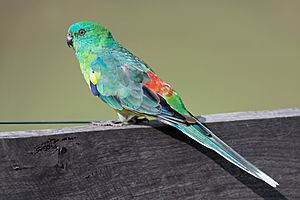
44 species recorded [42 extant native, 1 extirpated native, 1 extinct native]
Parrots are known for their strong, curved beaks, upright way of standing, and special feet with claws that help them grip. Many are super colorful, with bright feathers in all sorts of patterns. These parrots live across Africa, Asia, and Oceania, including Australia and New Zealand.
| Common name | Binomial | Notes |
|---|---|---|
| Superb parrot | Polytelis swainsonii | |
| Regent parrot | Polytelis anthopeplus | |
| Princess parrot | Polytelis alexandrae | |
| Australian king-parrot | Alisterus scapularis | |
| Red-winged parrot | Aprosmictus erythropterus | |
| Eclectus parrot | Eclectus roratus | |
| Red-cheeked parrot | Geoffroyus geoffroyi | |
| Ground parrot | Pezoporus wallicus | |
| Night parrot | Pezoporus occidentalis | |
| Bourke's parrot | Neopsephotus bourkii | |
| Blue-winged parrot | Neophema chrysostoma | |
| Elegant parrot | Neophema elegans | |
| Rock parrot | Neophema petrophila | |
| Orange-bellied parrot | Neophema chrysogaster | |
| Turquoise parrot | Neophema pulchella | |
| Scarlet-chested parrot | Neophema splendida | |
| Swift parrot | Lathamus discolor | |
| Red-crowned parakeet | Cyanoramphus novaezelandiae | extirpated, Macquarie Island |
| Norfolk Island parakeet | Cyanoramphus cookii | Norfolk Island |
| Australian ringneck | Barnardius zonarius | |
| Green rosella | Platycercus caledonicus | |
| Crimson rosella | Platycercus elegans | |
| Yellow rosella | Platycercus elegans flaveolus | |
| Northern rosella | Platycercus venustus | |
| Eastern rosella | Platycercus eximius | |
| Pale-headed rosella | Platycercus adscitus | |
| Western rosella | Platycercus icterotis | |
| Greater bluebonnet | Northiella haematogaster | |
| Naretha bluebonnet | Northiella narethae | |
| Red-rumped parrot | Psephotus haematonotus | |
| Mulga parrot | Psephotellus varius | |
| Hooded parrot | Psephotellus dissimilis | |
| Golden-shouldered parrot | Psephotellus chrysopterygius | |
| Paradise parrot | Psephotellus pulcherrimus | extinct |
| Red-capped parrot | Purpureicephalus spurius | |
| Double-eyed fig-parrot | Cyclopsitta diophthalma | |
| Budgerigar | Melopsittacus undulatus | |
| Musk lorikeet | Glossopsitta concinna | |
| Little lorikeet | Parvipsitta pusilla | |
| Purple-crowned lorikeet | Parvipsitta porphyrocephala | |
| Varied lorikeet | Psitteuteles versicolor | |
| Coconut lorikeet | Trichoglossus haematodus | Torres Strait |
| Red-collared lorikeet | Trichoglossus rubritorquis | |
| Rainbow lorikeet | Trichoglossus moluccanus | |
| Scaly-breasted lorikeet | Trichoglossus chlorolepidotus |
Lyrebirds
Order: Passeriformes Family: Menuridae
2 species recorded [2 extant native]
Lyrebirds are famous for their amazing ability to copy sounds from their surroundings, like other birds, animals, and even human noises! The male lyrebird also has a beautiful, large tail that he fans out to impress females.
| Common name | Binomial | Notes |
|---|---|---|
| Albert's lyrebird | Menura alberti | |
| Superb lyrebird | Menura novaehollandiae |
Bowerbirds
Order: Passeriformes Family: Ptilonorhynchidae
11 species recorded [11 extant native]
Bowerbirds are small to medium-sized birds, and the males are truly special! To attract a female, the male builds a unique structure called a 'bower.' These can be simple clearings with twigs or fancy decorated huts made of sticks and leaves.
| Common name | Binomial | Notes |
|---|---|---|
| Spotted catbird | Ailuroedus maculosus | |
| Black-eared catbird | Ailuroedus melanotis | |
| Green catbird | Ailuroedus crassirostris | |
| Tooth-billed bowerbird | Scenopoeetes dentirostris | |
| Golden bowerbird | Amblyornis newtonianus | |
| Regent bowerbird | Sericulus chrysocephalus | |
| Satin bowerbird | Ptilonorhynchus violaceus | |
| Western bowerbird | Ptilonorhynchus guttatus | |
| Spotted bowerbird | Ptilonorhynchus maculatus | |
| Great bowerbird | Ptilonorhynchus nuchalis | |
| Fawn-breasted bowerbird | Ptilonorhynchus cerviniventris |
Fairywrens
Order: Passeriformes Family: Maluridae
26 species recorded [26 extant native]
Fairywrens are small, insect-eating birds found only in Australia and New Guinea. They are known for their interesting social lives: while a male and female might pair up, they often help raise chicks from other partners too!
| Common name | Binomial | Notes |
|---|---|---|
| Grey grasswren | Amytornis barbatus | |
| Rufous grasswren | Amytornis whitei | |
| Opalton grasswren | Amytornis rowleyi | |
| Striated grasswren | Amytornis striatus | |
| White-throated grasswren | Amytornis woodwardi | |
| Carpentarian grasswren | Amytornis dorotheae | |
| Short-tailed grasswren | Amytornis merrotsyi | |
| Western grasswren | Amytornis textilis | |
| Thick-billed grasswren | Amytornis modestus | |
| Black grasswren | Amytornis housei | |
| Eyrean grasswren | Amytornis goyderi | |
| Dusky grasswren | Amytornis purnelli | |
| Kalkadoon grasswren | Amytornis ballarae | |
| Southern emuwren | Stipiturus malachurus | |
| Rufous-crowned emuwren | Stipiturus ruficeps | |
| Mallee emuwren | Stipiturus mallee | |
| Purple-crowned fairywren | Malurus coronatus | |
| Red-winged fairywren | Malurus elegans | |
| Blue-breasted fairywren | Malurus pulcherrimus | |
| Purple-backed fairywren | Malurus assimilis | |
| Variegated fairywren | Malurus lamberti | |
| Lovely fairywren | Malurus amabilis | |
| Splendid fairywren | Malurus splendens | |
| Superb fairywren | Malurus cyaneus | |
| White-winged fairywren | Malurus leucopterus | |
| Red-backed fairywren | Malurus melanocephalus |
Honeyeaters
Order: Passeriformes Family: Meliphagidae
76 species recorded [76 extant native]
Honeyeaters are a large group of small to medium-sized birds, mostly found in Australia and New Guinea. They love to drink nectar from flowers, just like hummingbirds, and are very diverse.
| Common name | Binomial | Notes |
|---|---|---|
| Eastern spinebill | Acanthorhynchus tenuirostris | |
| Western spinebill | Acanthorhynchus superciliosus | |
| Pied honeyeater | Certhionyx variegatus | |
| Yellow-spotted honeyeater | Meliphaga notata | |
| Lewin's honeyeater | Meliphaga lewinii | |
| White-lined honeyeater | Territornis albilineata | |
| Kimberley honeyeater | Territornis fordiana | |
| Graceful honeyeater | Microptilotis gracilis | |
| Cryptic honeyeater | Microptilotis imitatrix | |
| Yellow honeyeater | Stomiopera flava | |
| White-gaped honeyeater | Stomiopera unicolor | |
| White-fronted honeyeater | Purnella albifrons | |
| Yellow-faced honeyeater | Caligavis chrysops | |
| Yellow-tufted honeyeater | Lichenostomus melanops | |
| Purple-gaped honeyeater | Lichenostomus cratitius | |
| Bell miner | Manorina melanophrys | |
| Noisy miner | Manorina melanocephala | |
| Yellow-throated miner | Manorina flavigula | |
| Black-eared miner | Manorina melanotis | |
| Bridled honeyeater | Bolemoreus frenatus | |
| Eungella honeyeater | Bolemoreus hindwoodi | |
| Spiny-cheeked honeyeater | Acanthagenys rufogularis | |
| Little wattlebird | Anthochaera chrysoptera | |
| Western wattlebird | Anthochaera lunulata | |
| Regent honeyeater | Anthochaera phrygia | |
| Red wattlebird | Anthochaera carunculata | |
| Yellow wattlebird | Anthochaera paradoxa | |
| Varied honeyeater | Gavicalis versicolor | |
| Mangrove honeyeater | Gavicalis fasciogularis | |
| Singing honeyeater | Gavicalis virescens | |
| Yellow-plumed honeyeater | Ptilotula ornata | |
| White-plumed honeyeater | Ptilotula penicillata | |
| Yellow-tinted honeyeater | Ptilotula flavescens | |
| Fuscous honeyeater | Ptilotula fusca | |
| Grey-headed honeyeater | Ptilotula keartlandi | |
| Grey-fronted honeyeater | Ptilotula plumula | |
| Brown-backed honeyeater | Ramsayornis modestus | |
| Bar-breasted honeyeater | Ramsayornis fasciatus | |
| Rufous-banded honeyeater | Conopophila albogularis | |
| Rufous-throated honeyeater | Conopophila rufogularis | |
| Grey honeyeater | Conopophila whitei | |
| Gibberbird | Ashbyia lovensis | |
| Yellow chat | Epthianura crocea | |
| Crimson chat | Epthianura tricolor | |
| Orange chat | Epthianura aurifrons | |
| White-fronted chat | Epthianura albifrons | |
| Black honeyeater | Sugomel nigrum | |
| Dusky honeyeater | Myzomela obscura | |
| Red-headed honeyeater | Myzomela erythrocephala | |
| Scarlet honeyeater | Myzomela sanguinolenta | |
| Tawny-crowned honeyeater | Gliciphila melanops | |
| Green-backed honeyeater | Glycichaera fallax | |
| Banded honeyeater | Cissomela pectoralis | |
| Brown honeyeater | Lichmera indistincta | |
| Crescent honeyeater | Phylidonyris pyrrhoptera | |
| New Holland honeyeater | Phylidonyris novaehollandiae | |
| White-cheeked honeyeater | Phylidonyris niger | |
| White-streaked honeyeater | Trichodere cockerelli | |
| White-eared honeyeater | Nesoptilotis leucotis | |
| Yellow-throated honeyeater | Nesoptilotis flavicollis | |
| Blue-faced honeyeater | Entomyzon cyanotis | |
| White-throated honeyeater | Melithreptus albogularis | |
| Gilbert's honeyeater | Melithreptus chloropsis | |
| White-naped honeyeater | Melithreptus lunatus | |
| Black-headed honeyeater | Melithreptus affinis | |
| Brown-headed honeyeater | Melithreptus brevirostris | |
| Black-chinned honeyeater | Melithreptus gularis | |
| Strong-billed honeyeater | Melithreptus validirostris | |
| Tawny-breasted honeyeater | Xanthotis flaviventer | |
| Macleay's honeyeater | Xanthotis macleayana | |
| Striped honeyeater | Plectorhyncha lanceolata | |
| Painted honeyeater | Grantiella picta | |
| Little friarbird | Philemon citreogularis | |
| Helmeted friarbird | Philemon buceroides | |
| Silver-crowned friarbird | Philemon argenticeps | |
| Noisy friarbird | Philemon corniculatus |
Crows, Jays, and Magpies
Order: Passeriformes Family: Corvidae
6 species recorded [5 extant native, 1 vagrant]
This family includes smart birds like crows, ravens, and magpies. They are usually larger than many other songbirds, and some species are known for being very intelligent.
| Common name | Binomial | Notes |
|---|---|---|
| House crow | Corvus splendens | vagrant, introduced and now extirpated |
| Torresian crow | Corvus orru | |
| Little crow | Corvus bennetti | |
| Australian raven | Corvus coronoides | |
| Little raven | Corvus mellori | |
| Forest raven | Corvus tasmanicus |
Australasian Robins
Order: Passeriformes Family: Petroicidae
23 species recorded [23 extant native]
Australasian robins are small, plump birds with round heads and short, straight beaks. They live in many different wooded areas, from cool mountain forests to warm rainforests and even dry scrublands. These birds mainly eat insects, but some also enjoy seeds.
| Common name | Binomial | Notes |
|---|---|---|
| Jacky-winter | Microeca fascinans | |
| Lemon-bellied flycatcher | Microeca flavigaster | |
| Yellow-legged flycatcher | Microeca griseoceps | |
| Scarlet robin | Petroica boodang | |
| Flame robin | Petroica phoenicea | |
| Rose robin | Petroica rosea | |
| Pink robin | Petroica rodinogaster | |
| Norfolk robin | Petroica multicolor | Norfolk Island |
| Red-capped robin | Petroica goodenovii | |
| Hooded robin | Melanodryas cucullata | |
| Dusky robin | Melanodryas vittata | |
| White-faced robin | Tregellasia leucops | |
| Pale-yellow robin | Tregellasia capito | |
| Eastern yellow robin | Eopsaltria australis | |
| Western yellow robin | Eopsaltria griseogularis | |
| White-breasted robin | Eopsaltria georgiana | |
| Mangrove robin | Peneonanthe pulverulenta | |
| White-browed robin | Poecilodryas superciliosa | |
| Buff-sided robin | Poecilodryas cerviniventris | |
| Ashy robin | Heteromyias albispecularis | |
| Grey-headed robin | Heteromyias cinereifrons | |
| Northern scrub-robin | Drymodes superciliaris | |
| Southern scrub-robin | Drymodes brunneopygia |
Images for kids
-
Magpie goose at Fogg Dam in the Northern Territory
-
Little tern with crested terns
-
Australian little egret
-
Pacific reef heron, dark morph
See also
- Birds of Australia, including links to state and local lists
- Lists of birds by region, including Oceania and Asia
- Fauna of Australia
- List of endemic birds of Australia


